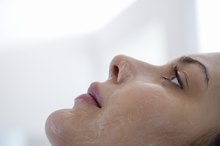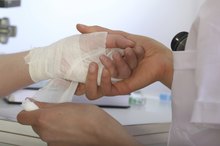How to Reduce Redness After a Chemical Peel
Chemical peels are used to improve your skin’s appearance and reduce fine lines, skin discoloration, dullness, acne scars and sun damage. They come in a variety of strengths, and the stronger peels penetrate deeper layers of skin. Redness can last from just a few hours to four weeks, depending on the strength of the peel. Although directions may vary according to your dermatologist, simple steps can reduce the amount of redness you experience.
Keep your skin covered after a deep chemical peel 1. Your doctor may cover your skin with a special dressing or bandage, then advise you to buy additional bandages. After a deep peel, coverings are used to protect the skin from elements, such as dirt and the sun, and reduce redness. Remove the bandage when your doctor tells you that you can.
How to Reduce Redness With Retin-A
Learn More
Treat your skin carefully. The American Academy of Dermatology states that scratching or rubbing your skin, even if it burns or itches, can increase redness and cause scarring. Your skin will most likely be peeling, but don’t poke at it or pick the flakes. Careful handling will reduce the amount and duration of redness.
Keep your skin moist. If it gets too dry, it will become more red and crack, causing scars. Your doctor may prescribe a certain moisturizer to use. If so, follow the application directions carefully. If he has not prescribed or recommended a moisturizer, use a gentle face lotion with no harsh ingredients, such as alcohol. Apply the moisturizer three to four times a day as needed.
Redness After a Chemical Peel
Learn More
Protect your sensitive skin from certain substances or temperatures. Avoid extreme temperatures or anything that could irritate your skin, such as spicy foods, until you have healed from your chemical peel. Also, avoid using makeup for about a week, or at least two weeks after a deep peel.
Apply a cool compress to your skin when you are able to remove the bandages. Wet a washcloth and press it gently onto your skin to soothe your skin and reduce redness.
Tips
Diligently follow specific directions from your dermatologist or plastic surgeon.
Use sunscreen regularly. Your skin will be more sensitive after a chemical peel and more susceptible to sun damage.
Warnings
Notify your doctor if redness worsens.
Related Articles
References
- AgingSkinNet: Chemical Peeling: What to Expect Before, During, and After
- Facial Plastic Surgery: Facial Peels and Laser Surgery
- O'connor AA, Lowe PM, Shumack S, Lim AC. Chemical peels: a review of current practice. Australas J Dermatol. 2018;59(3):171-181. doi:10.1111/ajd.12715
- Castillo DE, Keri JE. Chemical peels in the treatment of acne: patient selection and perspectives. Clin Cosmet Investig Dermatol. 2018;11:365–372. doi:10.2147/CCID.S137788
- Soleymani T, Lanoue J, Rahman Z. A practical approach to chemical peels: a review of fundamentals and step-by-step algorithmic protocol for treatment. J Clin Aesthet Dermatol. 2018;11(8):21–28.
- Cleveland Clinic. Chemical peels: what to expect.
- Cleveland Clinic. Chemical peels: how to prepare.
- Stanford Healthcare. Techniques: our approach to chemical skin peels.
- Cleveland Clinic. What results can I expect?.
Writer Bio
Rose Welton is a journalism major and a freelance writer. Her education is focused on nutrition and early childhood studies, making her an expert when it comes to writing about health and children's growth and development. She has written numerous articles and blog posts on various topics for online publications and has also worked on an Internet news team.









